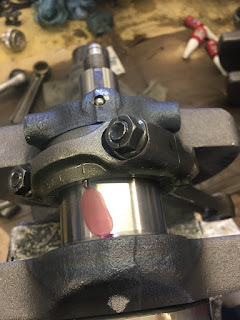The story starts with me being a bit unhappy about the engine, which I built lately. In essence, I've built the perfect race-engine, not much grunt down low, but oh-boy does it rev. (And make stupid power in the progress.) Unfortunately the specs said "everyday-engine" and it was rather bad at that compared to what I had before. So I inquired about combining the heavy crank with my BT/XVS/V-star rotating assembly and the universal answer was: don't. Prior to asking those questions, I had thrown some crude maths at it. (I will get into the intricacies of how and why this isn't very precise and you should do it differently in a subsequent post.) And worked out that the balance factor will go up, not realising that the new conrods have got lighter small-ends and that would limit the effects quite substantially.
From left to right: stock XV1100, XV1100 crank with light pistons and with the correct conrods as well. (The last calculation was done after I had the engine open and was able to extract crank and conrods.)
And with that being said, I went through my stash of XV1100 cranks, dug out the one that was in the engine before and cleaned and stripped it.
Then the current engine had to be freed from its confinement, not without marking the exhaust joints and the coil-plugs to be able to fit them together as they were before.
Pulling the engine apart revealed a nice surprise, the XV700 heads are working flawlessly with the tightened squishband as can be witnessed by the clean areas in the head where turbulence is happening.
And that's the case more or less stripped down to the crank and gearbox.
A quick check of the clearances between crank and conrod revealed Yamaha hadn't changed their tolerance codes and I made a spot on landing in the middle of the tolerance field with 0.040mm clearance, when combining BT-conrods with a XV1100 crankshaft.
And there we have the unholy union, called bumblebee. Also my assembly lube is a bit stiff.
Then followed the usual steps of reassembling the engine:
Heating the case around the main bearing seat.
Pull the crank in.
Button everything up.
And then fill the case with all the bits.
Lube up the small-ends and fit the pistons.
On a slightly unhappy tone: If your gudgeon pin clips feel weird when fitting, recheck. Turns out my brand new clips obviously were annealed incorrectly and weren't springy at all.
Fit the cylinders and use rtv-silicone instead of the base gasket.
Lube up the cams, bolt the heads on ... you get the picture, right?

Get it all in a frame or more precisely put the frame on top of it and get it ready to fire up.

I also took some time to clean up the exhaust with some WD40.
And then it was to put my money, where my mouth is and fire her up.
So what's it like: It's basically an XV1100 engine again, but with notably less vibrations. Actually hardly any vibrations at idle at all, which is almost a bit irritating. It has got low-down torque for miles and obviously it doesn't like to rev as hard or rev-up as fast as with the lighter BT crank. And incidentially it proved a point: a roughly 3 percent change in crank balance factor can be felt, if you compare them back to back.





























No comments:
Post a Comment